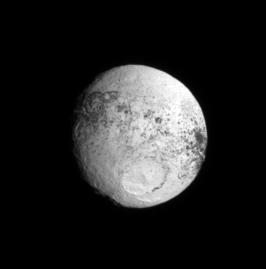Flyby Follow-up

| PIA Number | PIA09756 |
|---|---|
| Language |
|
Following Cassini's highly successful flyby of Iapetus in September 2007, the spacecraft repeatedly glanced back at the two-toned moon for some time. As Cassini receded from Iapetus, more and more of the bright trailing hemisphere rotated into view.
This image shows terrain farther west of that visible in The Other Side of Iapetus. Most notably in this view, it can be seen that the dark equatorial terrain reaches onto the moon's trailing side by the same amount on the western and eastern sides.
This view looks toward Iapetus (1,468 kilometers, or 912 miles, across) from about 10 degrees south of the moon's equator and is centered on 284 degrees west longitude. North is up and rotated 16 degrees to the right.
The image was taken in visible light with the Cassini spacecraft narrow-angle camera on Sept. 19, 2007. The view was acquired at a distance of approximately 1.7 million kilometers (1 million miles) from Iapetus and at a sun-Iapetus-spacecraft, or phase, angle of 32 degrees. Image scale is 10 kilometers (6 miles) per pixel.
The Cassini-Huygens mission is a cooperative project of NASA, the European Space Agency and the Italian Space Agency. The Jet Propulsion Laboratory, a division of the California Institute of Technology in Pasadena, manages the mission for NASA's Science Mission Directorate, Washington, D.C. The Cassini orbiter and its two onboard cameras were designed, developed and assembled at JPL. The imaging operations center is based at the Space Science Institute in Boulder, Colo.
The Cassini-Huygens mission is a cooperative project of NASA, the European Space Agency and the Italian Space Agency. The Jet Propulsion Laboratory, a division of the California Institute of Technology in Pasadena, manages the mission for NASA's Science Mission Directorate, Washington, D.C. The Cassini orbiter and its two onboard cameras were designed, developed and assembled at JPL. The imaging operations center is based at the Space Science Institute in Boulder, Colo.
For more information about the Cassini-Huygens mission visit http://saturn.jpl.nasa.gov . The Cassini imaging team homepage is at http://ciclops.org .
Credit: NASA/JPL/Space Science Institute
